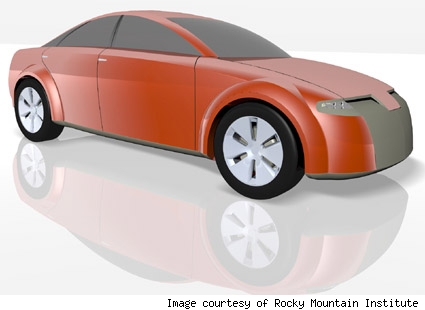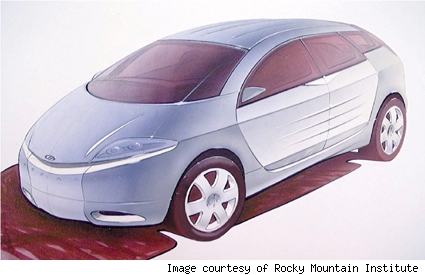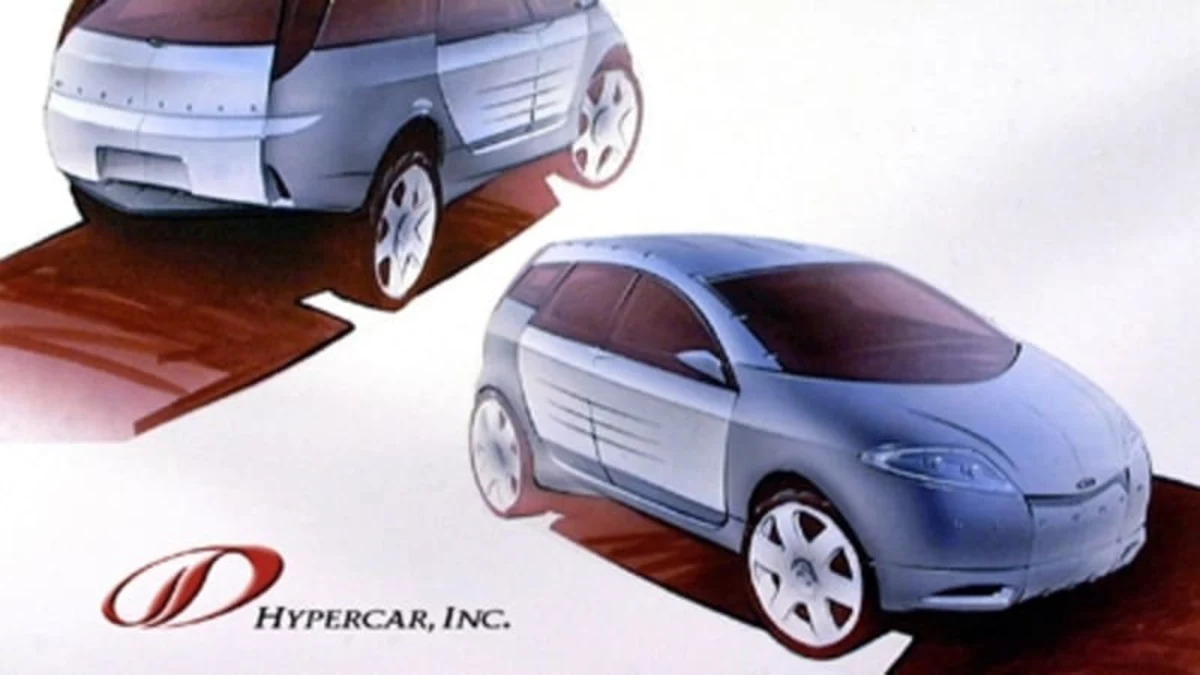The Rocky Mountain Institute (RMI), a non-profit organisation, was established in 1982 by resource analysts L. Hunter Lovins and Amory B. Lovins in response to the oil crisis of the late 1970s and early 1980s to examine and consult on energy policy. RMI now has around 40 full-time staff and consults to extensively to the automotive industry, amongst others.
In 1991, RMI proposed the Hypercar ultralight vehicle concept designed to maximise efficiency as a synergistic union of ultralight materials formed into an ultra-low-drag vehicle body powered by a hybrid electric drive. Separately, these design ideas have advantages and drawbacks, but by combining them together, a synergy can be created between the individual elements, which multiplies the benefits.
The need for the Hypercar to exist was based on the fact that while remarkable advances have been made in automotive technology, today's vehicles are still incredibly inefficient, using only about one percent of their fuel energy to propel the driver due to massive engine and powertrain losses through heat and friction. Just 15–20 percent of the fuel energy reaches the wheels, but due to the great mass of a modern vehicle compared to the driver, around 95 percent of this fuel energy reaching the road just moves the car, leaving one percent of the original fuel energy to move the driver. Hypercar vehicles are designed to minimise these energy losses, increasing by tenfold the fraction of the final energy that actually moves the driver.
See more about the Hypercar - its background, history and more images - after the jump.
The basic concept of a Hypercar is if you can make the body panels and structural frame out of lightweight carbon fiber composite, you reduce the weight of the vehicle substantially - which then allows you to achieve greater performance and/or efficiency. To this point, lightweight composite design has been expensive so it has only really been used as a way to increase performance in, for example, Formula 1 cars. If efficiency is your primary goal though, by reducing the weight of the car, you can reduce the size of the engine required. If you reduce the size of the engine though, that reduces the weight further allowing you to reduce the engine size even more. If the car weighs less, the brakes and other components can be smaller. And once you're trying to move around a car weighting a less than half as much, you're obviously going to use less fuel no matter what drive train technology you incorporate.
But massive fuel efficiency improvements are just one side of the coin. In a high volume environment like automobile manufacturing, improving efficiency can bring down the price a lot. If you are making a car using lightweight carbon fibre composite, the carbon fibre raw materials can be mixed, cured and pressed into shape on-site meaning you don't have to transport in heavy steel raw materials which saves on your input costs. If different pigments can be mixed in with the carbon fibre when its made, you don't have to paint your cars any more, saving you an entire paint shop. If the carbon fibre can be pressed into really complicated moulds, you need less individual pieces to make a car body, saving time in labour to deal with the hundreds of bits that make up cars today. If the pieces themselves can be carried around by hand because they're so light, you don't need cranes and heavy lifting equipment any more. If the pieces can be snapped together like Lego blocks and bonded with special glues, you don't need welding equipment any more. If the final cars are lighter, you wont use as much energy to move ship them to their final destination. And all the way along the manufacture process, from top to bottom, you can save money which effectively offsets the higher cost of using carbon fibre in the first place.
Increased safety is another by-product of vehicles manufactured with lightweight carbon fiber composites. By virtue of being stronger and stiffer than metals, advanced composites can absorb five times more energy per pound in a collision. And being lighter, advanced composite cars carry less momentum than heavier cars, making collisions less deadly to the people they hit.

Between 1991 and 1993, RMI refined and validated the Hypercar concept through peer review by scores of industry and independent experts. It was determined that a lightweight carbon fiber composite Hypercar would be four to eight times more efficient than an electric vehicle using standard sheet metal automotive construction technology.
In 1993, the concept was publicly released at the International Symposium on Automotive Technology and Automation with supporting details. After receiving the Nissan Prize, RMI organised a dedicated conference on Hypercars in 1994. Also that year, RMI founded the Hypercar Center, an additional nonprofit arm dedicated to supporting the rapid commercialisation of ultralight hybrid vehicles.
From 1994 to 1996, Hypercar Center's emphasis was on further validating the concept from design and market perspectives through computer modeling and by publishing technical papers. demonstrating that Hypercar vehicles could work, that all market requirements could be met, and that the myriad of technical challenges could be overcome.
In early 1996 the landmark technical assessment, "Hypercars: Materials, Manufacturing, and Policy Implications" was published.
By mid-1997 the Hypercar Center was engaged in discussions and collaboration with around 30 current or intending automakers
In 1999 Hypercar, Inc. was spun off as a for-profit start-up company to commercialise the Hypercar concept and to start getting them made. And by 2000, all key technologies had been demonstrated.
It was expected that well-integrated models would be expected on market in 2003–05, but I guess the dot com crash and 9/11 have both set the timeline back. There is certainly a great deal of activity in the industry towards hybrid and pure electric drive systems, but less so in the use of lighweight materials.
RMI has since morphed Hypercar, Inc into Fibreforge, which now specialise in the manufacture of incredibly lightweight structures for high volume applications. Hopefully we'll see more carbon fibre composites and other light weight materials making it into new vehicles in the next few years.
Stay tuned to AutoblogGreen for an upcoming interview with Michael Brylawski, Senior Consultant at the Rocky Mountain Institute, who co-founded the Hypercar, Inc. spin-off.
UPDATE: The in-depth interview with Brylawski starts here.
Related:


In 1991, RMI proposed the Hypercar ultralight vehicle concept designed to maximise efficiency as a synergistic union of ultralight materials formed into an ultra-low-drag vehicle body powered by a hybrid electric drive. Separately, these design ideas have advantages and drawbacks, but by combining them together, a synergy can be created between the individual elements, which multiplies the benefits.
The need for the Hypercar to exist was based on the fact that while remarkable advances have been made in automotive technology, today's vehicles are still incredibly inefficient, using only about one percent of their fuel energy to propel the driver due to massive engine and powertrain losses through heat and friction. Just 15–20 percent of the fuel energy reaches the wheels, but due to the great mass of a modern vehicle compared to the driver, around 95 percent of this fuel energy reaching the road just moves the car, leaving one percent of the original fuel energy to move the driver. Hypercar vehicles are designed to minimise these energy losses, increasing by tenfold the fraction of the final energy that actually moves the driver.
See more about the Hypercar - its background, history and more images - after the jump.
The basic concept of a Hypercar is if you can make the body panels and structural frame out of lightweight carbon fiber composite, you reduce the weight of the vehicle substantially - which then allows you to achieve greater performance and/or efficiency. To this point, lightweight composite design has been expensive so it has only really been used as a way to increase performance in, for example, Formula 1 cars. If efficiency is your primary goal though, by reducing the weight of the car, you can reduce the size of the engine required. If you reduce the size of the engine though, that reduces the weight further allowing you to reduce the engine size even more. If the car weighs less, the brakes and other components can be smaller. And once you're trying to move around a car weighting a less than half as much, you're obviously going to use less fuel no matter what drive train technology you incorporate.
But massive fuel efficiency improvements are just one side of the coin. In a high volume environment like automobile manufacturing, improving efficiency can bring down the price a lot. If you are making a car using lightweight carbon fibre composite, the carbon fibre raw materials can be mixed, cured and pressed into shape on-site meaning you don't have to transport in heavy steel raw materials which saves on your input costs. If different pigments can be mixed in with the carbon fibre when its made, you don't have to paint your cars any more, saving you an entire paint shop. If the carbon fibre can be pressed into really complicated moulds, you need less individual pieces to make a car body, saving time in labour to deal with the hundreds of bits that make up cars today. If the pieces themselves can be carried around by hand because they're so light, you don't need cranes and heavy lifting equipment any more. If the pieces can be snapped together like Lego blocks and bonded with special glues, you don't need welding equipment any more. If the final cars are lighter, you wont use as much energy to move ship them to their final destination. And all the way along the manufacture process, from top to bottom, you can save money which effectively offsets the higher cost of using carbon fibre in the first place.
Increased safety is another by-product of vehicles manufactured with lightweight carbon fiber composites. By virtue of being stronger and stiffer than metals, advanced composites can absorb five times more energy per pound in a collision. And being lighter, advanced composite cars carry less momentum than heavier cars, making collisions less deadly to the people they hit.

Between 1991 and 1993, RMI refined and validated the Hypercar concept through peer review by scores of industry and independent experts. It was determined that a lightweight carbon fiber composite Hypercar would be four to eight times more efficient than an electric vehicle using standard sheet metal automotive construction technology.
In 1993, the concept was publicly released at the International Symposium on Automotive Technology and Automation with supporting details. After receiving the Nissan Prize, RMI organised a dedicated conference on Hypercars in 1994. Also that year, RMI founded the Hypercar Center, an additional nonprofit arm dedicated to supporting the rapid commercialisation of ultralight hybrid vehicles.
From 1994 to 1996, Hypercar Center's emphasis was on further validating the concept from design and market perspectives through computer modeling and by publishing technical papers. demonstrating that Hypercar vehicles could work, that all market requirements could be met, and that the myriad of technical challenges could be overcome.
In early 1996 the landmark technical assessment, "Hypercars: Materials, Manufacturing, and Policy Implications" was published.
By mid-1997 the Hypercar Center was engaged in discussions and collaboration with around 30 current or intending automakers
In 1999 Hypercar, Inc. was spun off as a for-profit start-up company to commercialise the Hypercar concept and to start getting them made. And by 2000, all key technologies had been demonstrated.
It was expected that well-integrated models would be expected on market in 2003–05, but I guess the dot com crash and 9/11 have both set the timeline back. There is certainly a great deal of activity in the industry towards hybrid and pure electric drive systems, but less so in the use of lighweight materials.
RMI has since morphed Hypercar, Inc into Fibreforge, which now specialise in the manufacture of incredibly lightweight structures for high volume applications. Hopefully we'll see more carbon fibre composites and other light weight materials making it into new vehicles in the next few years.
Stay tuned to AutoblogGreen for an upcoming interview with Michael Brylawski, Senior Consultant at the Rocky Mountain Institute, who co-founded the Hypercar, Inc. spin-off.
UPDATE: The in-depth interview with Brylawski starts here.
Related:
- Battery companies battle it out for market share
- Oshkosk Using Copper Motor Rotor Technology For Military
- Obvio! contracts Lotus to design trybrid cars




Sign in to post
Please sign in to leave a comment.
Continue